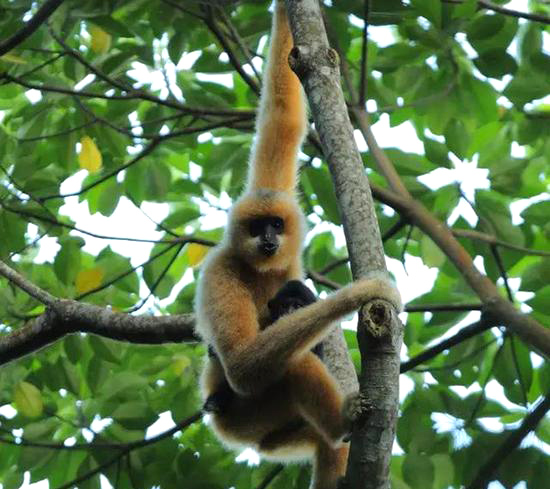Extinct gibbon species discovered in ancient Chinese tomb

In China, gibbons can only be seen in several southern provinces nowadays.
XI’AN—Chinese and British researchers have discovered bones of a hitherto unknown extinct genus of gibbon in a tomb in China’s Shaanxi Province. The tomb, which is at least 2,200 years old, is believed to belong to Lady Xia, the grandmother of Qin Shi Huang (259-210 BCE), or the First Qin Emperor who united China into an empire for the first time.
The tomb where the gibbon was discovered is located in Shenheyuan, Chang’an District, Xi’an City, said Ding Yan, a research fellow at the Shaanxi Provincial Institute of Archaeology. From 2004 to 2008, archaeologists conducted archaeological excavations on the mausoleum.
The gibbon was unearthed in the K12 pit of grave goods southeast of the tomb. The pit is in the shape of a long bar 14 meters long, 2.5 meters wide and 3.7 meters deep, and it is filled with a variety of animals. The northern part contains rare birds while the southern part houses other animals, including a Eurasian lynx, a leopard, two Asiatic black bears and a sheep. The partial skull, jaw and forelimb bones of the gibbon lie on the eastern side of this part.
Hu Songmei, a research fellow at the Shaanxi Provincial Institute of Archaeology, entered the site in the first place. Hu said a gibbon has never been discovered in a pit of grave goods. Gibbons usually inhabit the forest and their skeletons tend to rapidly decompose after death, so it is extremely rare to discover ancient gibbon remains anywhere.
Few gibbon fossils and bones have been found in China, and in most cases, discoveries are mostly limited to a few teeth and broken bones, which makes it difficult to definitively identify genus and species. In addition to the partial skull of the gibbon, some incomplete upper limb bones have also been discovered, providing valuable information for species identification.
Through morphological observations, 3D modeling and measurement of 16 landmarks, experts from Shaanxi Provincial Institute of Archaeology and the Zoological Society of London and other institutes have differentiated the gibbon from the extant hylobatid genera and the extinct Quaternary gibbon Bunopithecus. Morphological comparison of the 3D digital scan with hundreds of gibbons in Asia as well as specimens in German and British collections has revealed that the characteristics of the species are very prominent and are clearly different from other genera and species, so it is believed to belong to a new genus and species. In research results recently published in the journal Science, it was given the name Junzi imperialis.
Hu said the genus name Junzi, a Chinese word of which one connotation is “superior,” comes from the Baopuzi, a work written in the Jin Dynasty in the fourth century: “The superiors are like apes and cranes, and the inferiors are like worms and sand.” The species name refers to the fact that the remains of the gibbon were unearthed from the tomb speculated to have belonged to a member of an imperial clan, Hu said.
According to records, gibbons began to decline before the 18th century and disappeared in the Three Gorges area and other places in China. By the 18th century, the gibbon population in Shaanxi’s Fengxiang Prefecture was extinct. In the 19th century, some remained in Zhouzhi, Huxian and Zhenping in Shaanxi. By the end of the 19th century and early 20th century, they had completely disappeared from the remaining sites scattered north of the Yangtze River.
According to The Gibbon in China by the Dutch Orientalist Robert van Gulik, as late as the 10th century, people in Chang’an had captured gibbons.
Judging from the distribution history of the gibbon in Shaanxi and the documented records, there were a certain number of gibbons in the forests along the northern slope of the Qinling Mountains in Shaanxi 2,200 years ago.
Rare birds and beasts have been found in pits of grave goods at the Hanyang Tomb and the Mausoleum of the First Qin Emperor in Shaanxi, but no gibbons have been found there. Archaeologists hope that in the future excavation, more rare animals like the gibbon can be discovered, and that more complete remains will be found, providing more and better data for analyzing the evolution and classification of gibbons.
LU HANG is a correspondent with Chinese Social Sciences Today.
(edited by JIANG HONG)

 PRINT
PRINT CLOSE
CLOSE